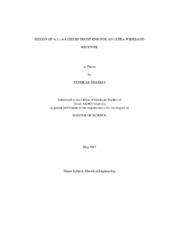| dc.description.abstract | IEEE 802.15 High Rate Alternative PHY task group (TG3a) is working to define
a protocol for Wireless Personal Area Networks (WPANs) which makes it possible to
attain data rates of greater than 110Mbps. Ultra Wideband (UWB) technology utilizing
frequency band of 3.168 GHz – 10.6 GHz is an emerging solution to this with data rates
of 110, 200 and 480 Mbps. Initially, UWB mode I devices using only 3.168 GHz – 4.752
GHz have been proposed.
Low Noise Amplifier (LNA) and I-Q mixers are key components constituting the
RF front-end. Performance of these blocks is very critical to the overall performance of
the receiver. In general, main considerations for the LNA are low noise, 50 broadband
input matching, high gain with maximum flatness and good linearity. For the mixers, it
is essential to attain low flicker noise performance coupled with good conversion gain.
Proposed LNA architecture is a derivative of inductive source degenerated topology.
Broadband matching at the LNA output is achieved using LC band-pass filter. To obtain
high gain with maximum flatness, an LC band-pass filter is used at its output. Proposed
LNA achieved a gain of 15dB, noise figure of less than 2.6dB and IIP3 of more than
-7dBm.
Mixer is a modified version of double balanced Gilbert cell topology where both
I and Q channel mixers are merged together. Frequency response of each sub-band is
matched by using an additional inductor, which further improves the noise figure and
conversion gain. Current bleeding scheme is used to further reduce the low frequency
noise. Mixer achieves average conversion gain of 14.5dB, IIP3 more than 6dBm and
Double Side Band (DSB) noise figure less than 9dB. Maximum variation in conversion
gain is desired to be less than 1dB. Both LNA and mixers are designed to be fabricated
in TSMC 0.18µm CMOS technology. | en |


